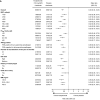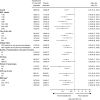Efficacy of Tezepelumab in Severe, Uncontrolled Asthma: Pooled Analysis of the PATHWAY and NAVIGATOR Clinical Trials
- PMID: 37015033
- PMCID: PMC10870853
- DOI: 10.1164/rccm.202210-2005OC
Efficacy of Tezepelumab in Severe, Uncontrolled Asthma: Pooled Analysis of the PATHWAY and NAVIGATOR Clinical Trials
Abstract
Rationale: Tezepelumab reduced exacerbations in patients with severe, uncontrolled asthma across a range of baseline blood eosinophil counts and fractional exhaled nitric oxide levels, and irrespective of allergy status, in the phase 2b PATHWAY (Study to Evaluate the Efficacy and Safety of MEDI9929 [AMG 157] in Adult Subjects With Inadequately Controlled, Severe Asthma; NCT02054130) and phase 3 NAVIGATOR (Study to Evaluate Tezepelumab in Adults & Adolescents With Severe Uncontrolled Asthma; NCT03347279) trials. Objectives: To examine the efficacy and safety of tezepelumab in additional clinically relevant subgroups using pooled data from PATHWAY and NAVIGATOR. Methods: PATHWAY and NAVIGATOR were randomized, double-blind, placebo-controlled trials with similar designs. This pooled analysis included patients with severe, uncontrolled asthma (PATHWAY, 18-75 years old; NAVIGATOR, 12-80 years old) who received tezepelumab 210 mg or placebo subcutaneously every 4 weeks for 52 weeks. The annualized asthma exacerbation rate over 52 weeks and secondary outcomes were calculated in the overall population and in subgroups defined by inflammatory biomarker levels or clinical characteristics. Measurements and Main Results: Overall, 1,334 patients were included (tezepelumab, n = 665; placebo, n = 669). Tezepelumab reduced the annualized asthma exacerbation rate versus placebo by 60% (rate ratio, 0.40 [95% confidence interval, 0.34-0.48]) in the overall population, and clinically meaningful reductions in exacerbations were observed in tezepelumab-treated patients with type 2-high and type 2-low disease by multiple definitions. Tezepelumab reduced exacerbation-related hospitalization or emergency department visits and improved secondary outcomes compared with placebo overall and across subgroups. The incidence of adverse events was similar between treatment groups. Conclusions: Tezepelumab resulted in clinically meaningful reductions in exacerbations and improvements in other outcomes in patients with severe, uncontrolled asthma, across clinically relevant subgroups. Clinical trials registered with www.clinicaltrials.gov (NCT02054130 [PATHWAY], NCT03347279 [NAVIGATOR]).
Keywords: asthma; biomarkers; eosinophil; thymic stromal lymphopoietin.
Figures




Comment in
-
In severe, uncontrolled asthma, tezepelumab reduced exacerbations over 1 y regardless of type 2 inflammation level.Ann Intern Med. 2023 Nov;176(11):JC128. doi: 10.7326/J23-0084. Epub 2023 Nov 7. Ann Intern Med. 2023. PMID: 37931261
References
-
- Global Initiative for Asthma. Global Initiative for Asthma; 2021. https://ginasthma.org/wp-content/uploads/2023/04/GINA-Main-Report-2021-V...
-
- Zeiger RS, Schatz M, Chen W, Li Q, Khatry DB, Tran TN. Adherent uncontrolled adult persistent asthma: characteristics and asthma outcomes. J Allergy Clin Immunol Pract . 2015;3:986–90.e2. - PubMed
-
- Zayed Y, Kheiri B, Banifadel M, Hicks M, Aburahma A, Hamid K, et al. Dupilumab safety and efficacy in uncontrolled asthma: a systematic review and meta-analysis of randomized clinical trials. J Asthma . 2019;56:1110–1119. - PubMed

